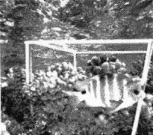
There are about 1.5 million kinds of living things on Earth, but how many do you see every day? You often see the big colourful animals, like birds, rabbits, and fish. But look more closely. Can you see the small ones, too? Insects (昆虫) make up 80 percent of all the world's living kinds. Look on the ground. Imagine you could look under the ground, too. Many small living things with one cell live there. Life is everywhere around us, in every cubic foot (a foot= 12 inches).
David Littschwager is a photographer who wanted to find out how many living things lived inone cubic foot. So he madea12-inch cube with a green metal frame. And then he put it in five habitats (栖息地). He chose a tropical rainforest (Costa Rica), a coral reef (Pacific Ocean), the Table Mountain (South Africa), a freshwater river(USA), and a small park(New York). Three weeks were spent at each place. He watched, counted, and took photos of everything down to I millimeter in size—that crawled (爬) or flew into the cube.
The results were amazing. Liittschwager found both common and rare living things. He discovered many new living kinds, like a strange transparent octopus that is the size of a fingernail! In total, more than a thousand living things were photographed. Liittchwager said the One Cubic Foot experience was like "finding treasure". David Liittschwager also found that the highest biodiversity (生物多样性) in the reef was in the skeleton coral (珊瑚遗骨). These skeleton coral are suitable for sea living things of all sizes to grow. Although the coral reef had the widest range of biodiversity, all the other habitats were full of life. Even the city park!
